Features
Was a Nazi war criminal living in St. James forced to hang himself by a Jewish “avenger” in 1960?
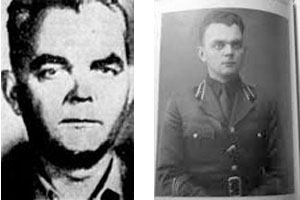
By BERNIE BELLAN The story of an alleged Nazi war criminal by the name of Alexander Laak, who was found hanging in his St. James garage in 1960, is one that has been revisited in this newspaper several times.
In October 1987, the late Gene Telpner first broached the story in our pages in one of his columns, when he wrote the following:
Quite a few columns ago I wrote about a book called “Forged in Fury”, which detailed the hanging in Winnipeg of an alleged war criminal by one or more Israeli “agents”.
They apparently had flown here, carried out the execution, and then caught a plane out of the city the same day.
At the time, the Free Press story reported the man’s death as a suicide, and the name given in the item was not his real one. His real name was Alexander Laak, and the wartime actions in which he allegedly participated took place in Estonia, near Tallin.
At one time, Laak worked at the RCAF base in Winnipeg. When he came to Canada from Europe he had received “clearance” from the British and Americans, but apparently the Russians wanted him back for further investigation.
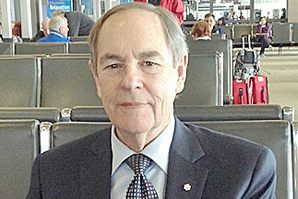
Now all of this original story was in 1960, and not until 1970, when the book Forged in Fury was published, did the details emerge. Those details came as a shock to Arthur Drache, son of Mr. and Mrs. Samuel Drache of this city, for several reasons.
For one, Arthur was a Free Press reporter when the “suicide” was printed and covered the story. Asked about it, Drache said, “We wrote a couple of stories “which received page one play, but did not give his name because of libel laws.”
But when Drache, who is now Arthur Drache Q.C. with the law firm of Drache Rotenberg in Ottawa, read “Forged in Fury”, he got full details for the first time. He wrote to the Free Press to tell them about the book’s revelations, but says he never got a response from the newspaper.
One of the saddest parts of the story to Drache is the fact that he and Laak’s son were classmates at Gordon Bell, and played on the school football team.
Laak was never publicly identified in Winnipeg while he was alive. It is believed that there had been accusations from some sources, but he protested his innocence.
Arthur Drache explained, “Only his ‘suicide’ allowed fuller disclosures and until I read “Forged in Fury” I was quite at a loss to explain his actions.”
Subsequently, in a February 20, 1991 issue of The Jewish Post & News, Myron Love had this story:
Manitoba RCMP looking into 30-year-old suicide of alleged Nazi
The Royal Canadian Mounted Police have re-opened an investigation into the apparent suicide 30 years ago of an alleged Estonian Nazi living in Winnipeg. The new investigation was requested by the provincial Attorney-General’s Department, following an article on the case last winter in the Winnipeg Free Press, and a subsequent letter by a member of the public to the attorney-general, asking that this possible murder be investigated, in light of the war crimes prosecutions taking place in the country.
Alexander Laak was found hanging in his garage on September 6, 1960, according to Sargent Wes Border of the RCMP’s General Investigation Section. The section is looking into the matter, after a series of newspaper reports from the Soviet Union, alleging Laak was a Nazi collaborator. The Winnipeg police investigated his death at the time.
A coroner’s inquest, headed by Dr. I.O. Fryer, then the province’s chief medical officer, ruled the death an apparent suicide, and the case was closed.
In the early 1970s, an author named Michael Elkin published a book called “Forged in Fury”, in which he described how an Israeli agent named Arnie Berg came to Winnipeg from South America, and gave Laak the choice of committing suicide or having him and his wife killed by Berg.
Last February, Winnipeg Free Press reporter Dave Roberts wrote a story on the case, with reference to Elkins’ report. (Roberts is unavailable for comment. He is currently in the Middle East.) The article also led to the attack on retired journalist Keith Rutherford by a couple of Skinheads in Alberta last year. The Skinheads claimed they were paying him back for exposing Laak. One claimed to be Laak’s son, but there is no record of any family. (Ed. note: Gene Telpner’s story does disclose that Laak had a son – also someone whom Arthur Drache knew, so the notion that Laak’s son may have been part of a group that attacked Rutherford is certainly plausible.)
Sgt. Border isn’t optimistic the GIS investigation will turn up anything. “Thirty years is a long time,” he says. “People are dead. Reports are no longer available to us.”
He reports contacts have been made with the war crimes investigation unit in Ottawa to check their information on Estonian war crimes, and with Israel to find out if Elkin’s book was fact or fiction. “We’re waiting to hear back to see if we should look into this more seriously,” he says. “With everything going on in the Middle East, and considering this is 30 years old, I don’t expect this matter will be pushed to the forefront. It’s a case that will not be easy to investigate.”
We’re playing catch-up.”
In the summer of 2014 I had written about a book titled “The Avengers”, which was about a group of Holocaust survivors led by Abba Kovner (who went on to become a famous Israeli poet). Subsequent to that book review I was reminded of the story of Alexander Laak, and I decided to try to find out whether there was anything more I could find out about the story – which apparently had reached a dead end.
I decided to attempt to contact Arthur Drache who, Gene Telpner had written, had actually covered the story of Alexander Laak’s “suicide” in 1960. Arthur Drache has been one of Canada’s best known tax attorneys for many years, has been the recipient of many awards. Several years ago Gerry Posner profiled Arthur Drache in an article for our paper titled , which can be found on our website at .
I called Arthur Drache in 2014 – and was surprised when he answered his phone himself. In any event, I recall that Mr. Drache was quite obliging – and had vivid memories of his own personal involvement in the Alexander Laak story. Here is what I wrote in August 2014:
As Gene Telpner mentions in his story, in 1960 Drache was working as a reporter for the Free Press. Drache told me, during a phone conversation, that he was a student at Brandeis University at the time.
Drache says that his assignment editor had received a tip that Laak was living in Winnipeg. According to Drache, it came from a Russian source. The Estonian community in Winnipeg was quite small at the time, Drache said, and it was an easy matter for him to track Laak down.
He told me that he and another reporter went to Laak’s house in St. James and spent some time speaking with him. According to Drache, Laak downplayed the role he had played in the Jägala camp in Estonia, describing his duties as akin to being “the warden of Stony Mountain”, in Drache’s words.
As Telpner noted in his story, Drache went on to write about Laak, but without revealing his true name. Drache said to me that he found the notion that a Mossad agent tracking Laak down and forcing him to commit suicide highly implausible.
But, I suggested to him, the same information that had been given to the Free Press, presumably by Russian authorities, might also have been given to the Israelis.
Drache did concede that point. He went on to say that immediately after he wrote his story about Laak, which was in late August, 1960, he recalled, he drove to Boston to resume his studies at Brandeis. On the way he happened to pick up a copy of the New York Times, which published a major story about the suicide of Alexander Laak but, as was the case with the Free Press story about the suicide, the NY Times story did not reveal his true name.
Drache also mentioned his personal connection to Alexander Laak – through Laak’s son. As Gene Telpner had written, they had both attended Gordon Bell High School, were classmates in fact and even played on the high school football team together. It was the fact that he knew Laak’s son that led his assignment editor at the Free Press to ask Drache to go to Laak’s house to interview him.
When the book “Forged in Fury” was published in 1970, Drache says he was shocked at the allegations made in that book about Laak.
Drache told me, “We wrote a couple of stories which received page one play, but did not give his (Laak’s) name because of libel laws.”
But when Drache read “Forged in Fury”, he was made aware of the full details surrounding Alexander Laak’s alleged background as a Nazi war criminal for the first time. He wrote to the Free Press to tell them about the book’s revelations, but says he never got a response from the newspaper.
Laak was never publicly identified in Winnipeg while he was alive. It is believed that there had been accusations from some sources, but he protested his innocence.
Arthur Drache explained, “Only his ‘suicide’ allowed fuller disclosures and until I read ‘Forged in Fury’ I was quite at a loss to explain his actions.”
One final footnote to this story: In attempting to find out more about Alexander Laak, I came across this information on a white supremacist website:
Alexander Laak , former commandant of the Jägala camp in Estonia where a large number of Jews were supposedly massacred, is alleged to have committed suicide by hanging in his garage in Winnipeg , Canada. A number of Laak’s subordinates had at the time been given harsh sentences at a Soviet show trial. According to an article in Der Tagespiegel September 8, 1960, Laak had declared the Soviet allegations against him to be “99% lies and Communist propaganda.” In Michael Elkin’s book Forged in Fury (1971) it is claimed that a Jewish “avenger” named Arnie Berg travelled to Winnipeg to kill Laak, and that Laak hanged himself under Berg’s supervision in order to not have his wife shot by Berg.
This entire story was brought to mind again when I started to watch a ridiculous TV show called “Hunters” which, although it has a stellar cast, is really nothing more than a comic book fantasy about Jewish avengers pursuing Nazis in America. Still, the story surrounding Alexander Laak’s suicide could make an interesting movie. Maybe Jonas Chernick would be interested?
Features
Japanese Straightening/Hair Rebonding at SETS on Corydon

Japanese Straightening is a hair straightening process invented in Japan that has swept America.

Features
History of the Winnipeg Beach Synagogue: 1950-2025

By BERNIE BELLAN The history of the Winnipeg Beach Synagogue is a fascinating one. We have had several articles over the years about the synagogue in The Jewish Post & News.

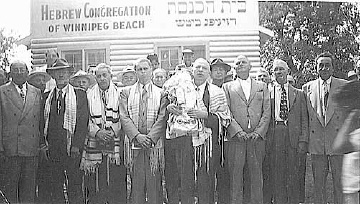
In June 2010 I wrote an article for The Jewish Post & News upon the 60th anniversary of the synagogue’s opening. Here are the opening paragraphs from that article:
“Sixty years ago a group of Winnipeg Beach vacationers decided that what their vacation area lacked was a synagogue. As it happened, a log cabin one-room schoolhouse in the Beausejour area happened to be available.
“In due course, the log cabin was relocated to the corner of Hazel and Grove in Winnipeg Beach, where it stayed for 48 years.”
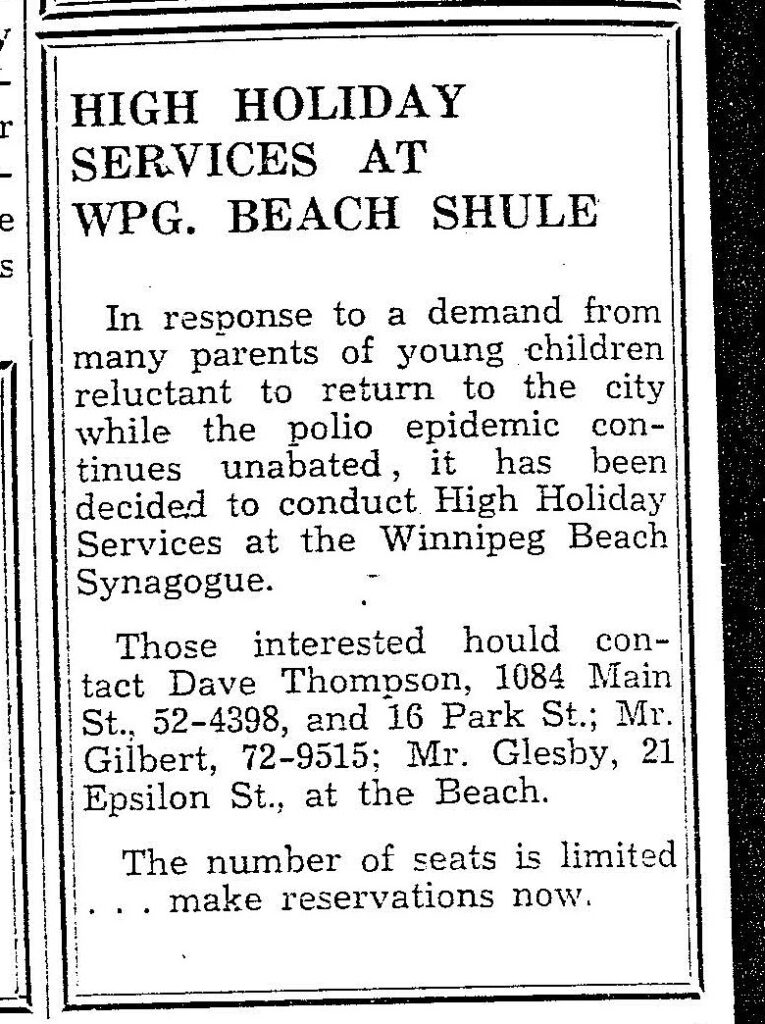
In December 1994 my late brother, Matt, wrote a story about the spraying of antisemitic grafitti on the synagogue which, at that time, was still situated at its original location on the corner of Hazel and Grove in the town of Winnipeg Beach:
“Two 16-year-olds spraypainted slogans like ‘Die Jews,’ ‘I’ll kill you Jews,’ and other grafitti in big letters on the beach synagogue.
“Jim Mosher, a news reporter for the Interlake Spectator in Gimli, said last Halloween’s vandalism against the synagogue wasn’t the first. In the late 1980s, he claimed, it was spraypainted with swastikas.
“Jack Markson, a longtime member of the Winnipeg Beach Synagogue, last week also said he could remember finding anti-Semitic grafitti spraypainted on the synagogue ‘a few years ago,’ and at least twice in the 1970s, when the cottage season was over.”
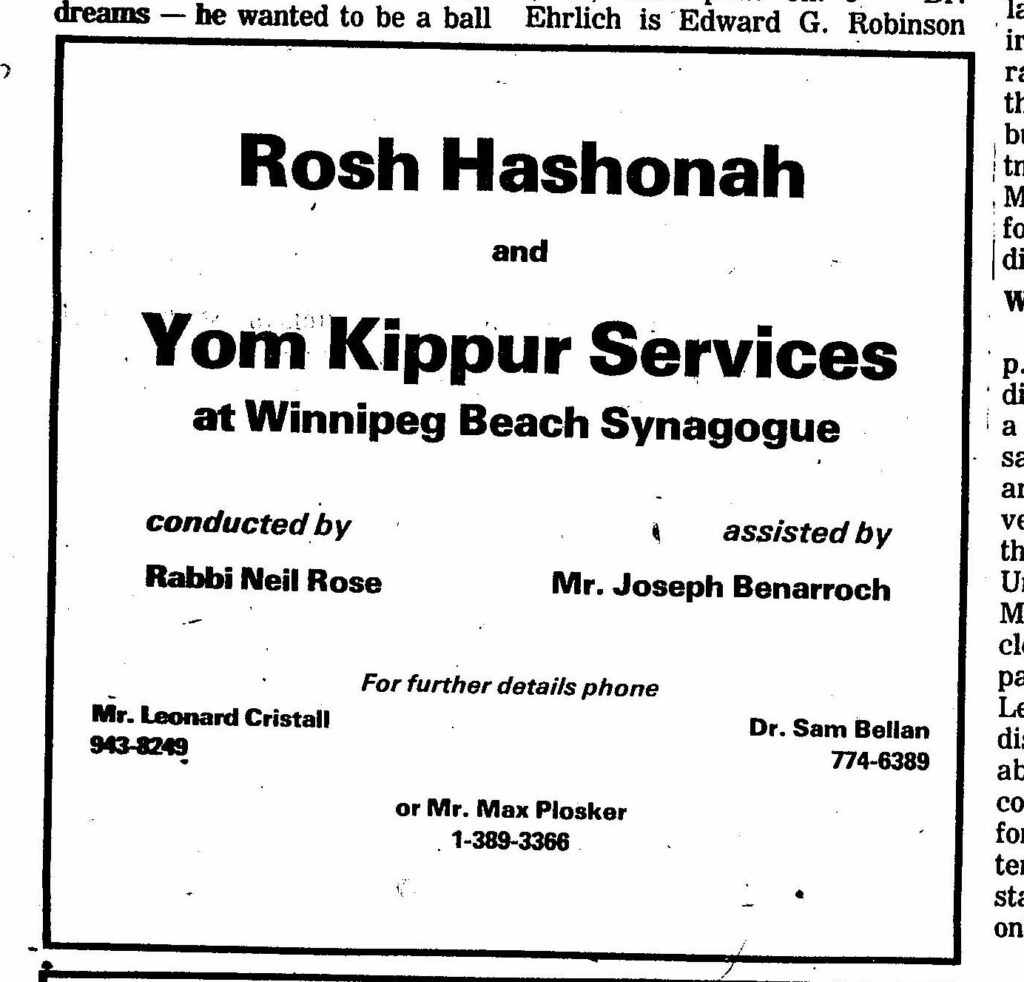
My 2010 article continued: “In 1998 the Town of Winnipeg Beach informed the members of the synagogue that the building would have to be hooked up to the town’s sewer and water system. Rather than incur the cost of $3-4,000, which was thought to be ‘prohibitive,’ according to longtime beach synagogue attendee Laurie Mainster, synagogue goers looked elsewhere for a solution.
“As a result, the board of Camp Massad was approached and asked whether the synagogue might be relocated there, with the understanding that the synagogue would be made available to the camp at any time other than what were then Friday evening and Saturday morning services.
“Over the years the ‘beach synagogue’ had come to be a very popular meeting place for summertime residents of Winnipeg Beach and Gimli. In fact, for years minyans were held twice daily, in addition to regular Saturday morning services. Of course, in those years Winnipeg Beach was also home to a kosher butcher shop.
“While the little synagogue, which measured only 18 x 24 feet, has gone through several transformations, including the move to Camp Massad, and the opening up to egalitarian services in 2007 (The move to egalitarian services was as much a practical necessity as it was a nod to the equality of women – the only Kohen present at the time was a woman!), it has always remained cramped at the best of times.
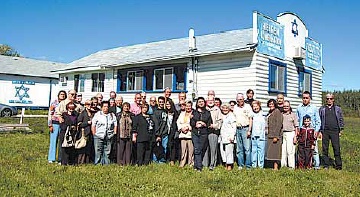
“In recent years the synagogue has seen the addition of a window airconditioner (although to benefit from it, you really have to be sitting just a few feet away), as well as a fridge that allows synagogue attendees to enjoy a regular Saturday morning Kiddush meal following the service.
“According to Laurie Mainster, the Saturday morning service has continued to be popular, even though many of the attendees now drive in from Winnipeg, as they have sold the cottages they once maintained.
“On the other hand, one of the side benefits to being located on Camp Massad’s grounds has been an infusion of young blood from among the camp counsellors.
“Since there is no longer a rabbi available to conduct services (Rabbi Weizman did lead services for years while he had a cottage at the beach), those in attendance now take turns leading the services themselves.
“Anyone may attend services and, while there are no dues collected, donations are welcome. (Donations should be made to the Jewish Foundation of Manitoba, with donors asked to specify that their donations are to be directed to the beach synagogue.)
“Mainster also says that the beach synagogue is now undergoing an expansion, which will be its first in 60 years. An entirely new space measuring 16 x 18 feet is being added – one that will allow for a real Kiddush area. (Until now, a table has been set up in the back of the synagogue and synagogue goers would help themselves to the buffet that is set up each Saturday during the summer. While pleasant enough, it will certainly be more comfortable to have an actual area set aside for the Saturday afternoon after service lunch.)
“As for dress, longtime attendee Abe Borzykowski (in an article written by Sharon Chisvin for the Free Press in 2007) remarked that ‘I don’t think there are many synagogues where people can attend in shorts, T-shirts and sandals and not feel out of place.’ “

As mentioned in that 2010 article, the beach synagogue at that time was about to undergo an extensive remodelling. Here is an article from a January 2011 issue that describes that remodelling process. The article was written by Bernie Sucharov, who has been a longtime member of the beach synagogue:
“The Hebrew Congregation of Winnipeg Beach made a major change to the synagogue this past summer. With the help of many volunteers, Joel Margolese being the project manager, the synagogue was expanded and an addition was built to handle the overflow crowds, as well as to add more space for the kiddush following services.
“The volunteers spent many Sundays during the summer months building the addition. Bad weather caused many delays, but finally the addition was completed one week before the official summer opening.
“The volunteers were: Joel Margolese, Gordon Steindel, Sheldon Koslovsky, Viktor Lewin, Harvey Zabenskie, Nestor Wowryk, Kevin Wowryk, Victor Spigelman, Jerry Pritchard, and David Bloomfield.
“On Sunday, June 25, 2010 a special ceremony was held to affix a mezzuzah to the front entrance door. Gordon Steindel had the honour of affixing the mezzuzah, which was donated by Sid Bercovich and Clarice Silver.
“Refreshments and food for the day were prepared by Phyllis Spigelman, also known as our catering manager. Throughout the summer, Phyllis, Lenore Kagan and other friends prepared the food for our kiddush.
“A sound system was donated by Arch and Brenda Honigman in memory of their father, Sam Honigman z”l. “The system was installed by Joel Margolese and Stevan Sucharov. This will allow the overflow crowd to hear the service in the new addition.
“There were also generous donations of 50 chumashim and an air conditioner. The chumashim were donated by Gwen, Sheldon and Mark Koslovsky. The air conditioner in the new addition was donated by Joel and Linda Margolese.
“The official opening of the synagogue for the summer took place on July 3, 2010. We had an overflow crowd of 70+ people.”
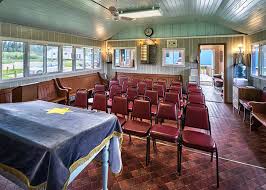
Since that 2010 major addition to the synagogue, it has also added a wheelchair ramp (although I’ve been unable to ascertain exactly when the ramp was built). Also, the synagogue also has its own outdoor privy now. (Attendees used to have to use facilities in Camp Massad.)
And, as already noted in article previously posted to this site (and which you can read at Beach Synagogue about to celebrate 75th anniversary), in recognition of that occasion, on August 2nd members of the synagogue will be holding a 75th anniversary celebration.
As part of the celebration anyone who is a descendant or relative of any of the original members of the first executive committee is invited to attend the synagogue that morning.
If you are a relative please contact Abe Borzykowski at wpgbeachshule@shaw.ca or aborzykowski@shaw.ca to let Abe know you might be attending.
Features
Kinzey Posen: CBC Winnipeg’s former “go-to guy”
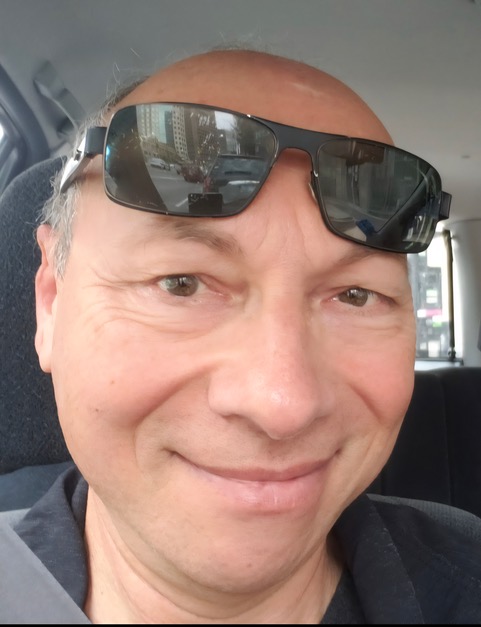
By GERRY POSNER If former Winnipegger Lawrence Wall was the CBC go-to guy in Ottawa, CBC Winnipeg had its own version of a go-to guy for many years with none other than the very well known Kinzey Posen. Of course, many readers will recognize that name from his career with Finjan, the Klezmer group so famous across Canada and beyond. It has been written about Posen and his wife Shayla Fink that they have been involved in music since they got out of diapers. And, as an aside, their love and ability in music has now been transmitted to the next generation as in their son, Ariel Posen (but that’s another story).
Kinzey Posen (not to be confused with Posner, or maybe we are to be confused, but who knows for sure?), was a graduate of Peretz School, having attended there from nursery right until Grade 7, graduating in1966. That was followed by Edmund Partridge and West Kildonan Collegiate. Musically, he was in large part self taught. However, he did have some teachers along the way. After moving to Vancouver – from 1974-78, he had the chance to study acoustic classical bass with a member of the Vancouver Symphony Orchestra. When Kinzey lived in Vancouver, he also worked as a jazz musician.
Upon returning to Winnipeg, Kinzey enrolled as a mature student at the University of Winnipeg, where he obtained a Bachelor of Urban Studies degree. Although the degree was in no way connected to the career that followed, his attending the University of Winnipeg was critical to his connecting with the CBC. Why? you ask. Kinzey had a position after graduation working for the Institute of Urban Studies. While there, he met someone who invited him to work for the Department of Continuing Education as one of their program directors. At the time the Department of Continuing Education was located at 491 Portage Avenue, which was also known as the TJ Rice Building. The CBC also leased some space in the same building. According to Kinzey, the CBC part of the building “included HR, different shows and other support offices. Continuing Education was located in the basement and main floor and that’s where I worked.”
KInzey had long had an interest in the CBC, which made the fact that the CBC had some offices in the same building where he was working serendipitous. That Kinzey might be interested in visiting the CBC was not an accident. As a young boy he had a nightly connection to CBC, as it was his ritual to listen to CBC Radio (as well as all sorts of other radio stations across the USA) on his transistor radio every night in bed. He became enamoured of one particular CBC host, Bill Guest, so that when going to sleep, he imagined that he was Guest doing interviews with imaginary guests. That dream of working for CBC became a reality when he had a chance to do a one week gig with Jack Farr’s network program.
Kinzey took a week off from his Continuing Education job and spent five days at the CBC. That week was a training session for Posen, as he had to create ideas, research, pre-interview, write the script, and set up the studio for Farr’s interview. He was almost in his dream job – although not quite – since it was only for one week. His opportunity, however, came in 1988, when he was offered a one-year term as a production assistant – the lowest guy on the ladder, for a show called “ Simply Folk,” with the late Mitch Podolak as the host. Although he was indeed at the bottom as far as those working on the show were concerned, he took a chance and gave his notice to the U of W. The rest is history. In his new job, Kinzey learned how to become a producer. Lucky for him, at the end of the year, when the person he replaced was supposed to come back, she never returned (just like the song, “MTA,” by the Kingston Trio). At that point, Kinzey was hired full time at the CBC.
Kinzey was a fixture at the CBC for 27 years. During those years, Kinzey had the chance to work with Ross Porter, a respected former CBC host and producer, also with Karen Sanders – on the “Afternoon Edition.” One aspect of Kinzey’s job on the Afternoon Edition was to come up with ideas, mix sound effects, arrange interviews and music, to create a two-hour radio experience. In addition, he covered jazz and folk festivals and, as a result, was exposed to some of the best musicians in the world. With Ross Porter in the 1990s, he worked on a network jazz show called “ After Hours,” which was on from 8-10 PM five nights a week. Kinzey was involved with writing the scripts, picking the music, and recording the shows, as well as editing them and then presenting them to the network for playback.
Of course, over his career, Kinzey had many memorable moments. He told me about one of them. The story revolved around the National Jazz Awards one year in particular. The awards were to be broadcasted after the National News which, in those days, began much earlier in the evening, and were over by 8:00 pm. The legendary Oscar Peterson was lined up to play a half hour set at the awards, starting at 7:30. But, as Kinzey told me, Oscar Peterson had a “hate on” for the CBC ecause one of his recorded performances was wrongly edited and he refused to appear on CBC under any circumstances. As the time neared 8:05 PM, which was when the CBC was to begin its broadcast of the jazz awards, it became apparent that Oscar was not going to finish on time. As the producer of the awards show, Kinzey was tasked with telling Oscar Peterson to wrap it up and get off the stage. There was Kinzey Posen, a huge fan of Oscar Peterson, now faced with the prospect of telling Oscar – while he was still playing – with 500 people in the audience, to stop and get off the stage. Not often was or is Kinzey Posen frozen, but that was one such moment. There was one loud “Baruch Hashem” from Kinzey when Oscar completed his set literally just in time.
Clearly, Kinzey was part of a very successful run with After Hours as it was on the air for 14 years. It was easily one of the most popular shows on CBC Radio 2, and a winner of several broadcasting awards. Kinzey also played a major role in producing a two part documentary about legendary guitarist Lenny Breau.
When After Hours ended, Posen became one of the contributing producers to Canada Live and specialized in producing live radio specials for the network, such as the Junos, for CBC Radio One and Two. Needless to say, his career planted Posen in the world of some top notch musicians, including his time spent working with Robert Plant (Led Zeppelin), Dave Brubeck, Randy Bachman, Chantal Kreviazuk and a list of prominent names in the Canadian, American and European music spheres. Locally, the CBC came to refer to Kinzey as the Jewish expert. I would add music expert to that title.
After his 27 year run at the CBC – and before he fully retired, Kinzey went on to work for the Rady JCC as a program director for a year and a half. Of course, to say that Kinzey Posen is retired is a major contradiction in terms. You really can’t keep him down and he has his hand in a variety of programs and projects – most of which he remains silent about, as is his style.
When I realized the full depth and talent of Kinzey Posen, I quickly concluded that he must certainly be related to me. Even if he isn’t, I now tell people he is.
